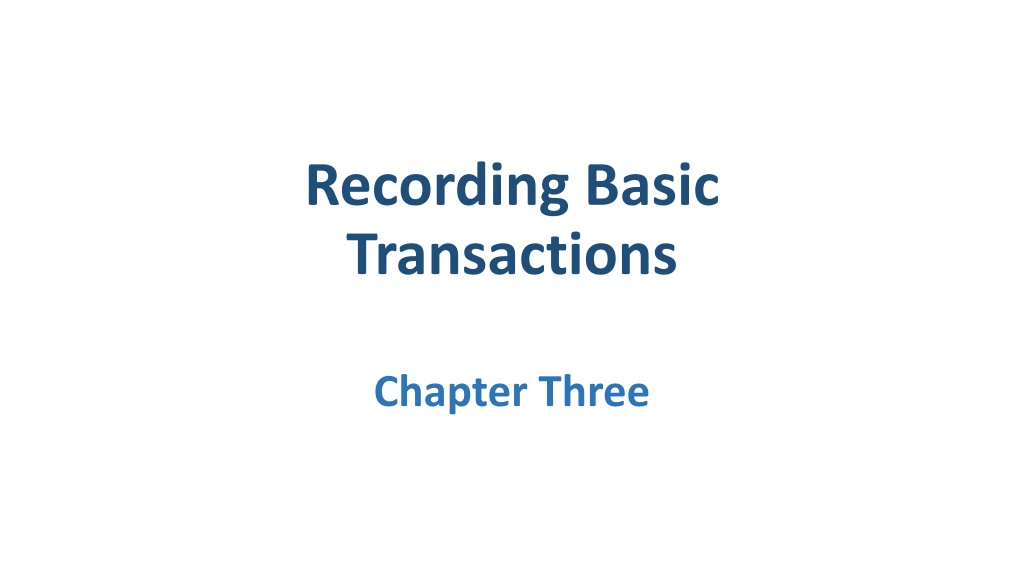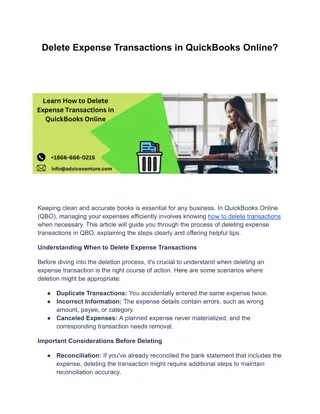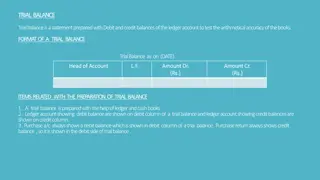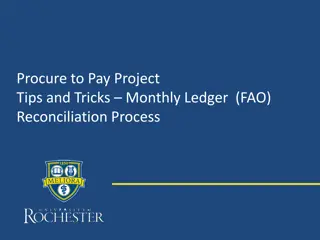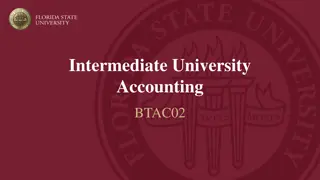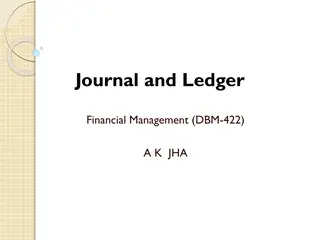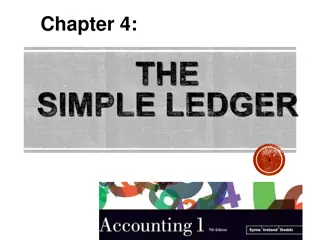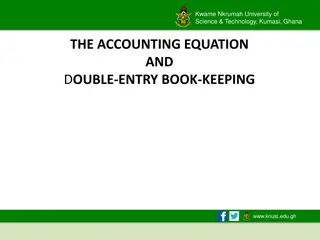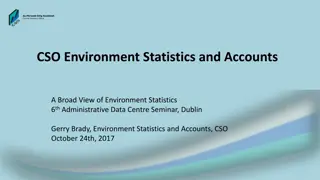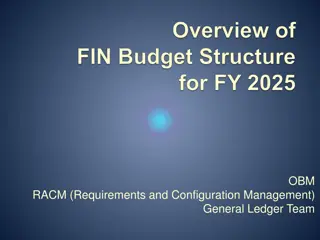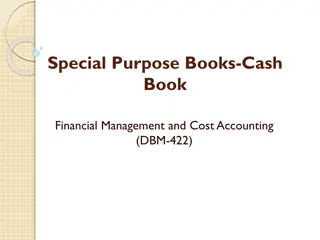Recording Basic Transactions in Ledger Accounts
Ledger accounts play a crucial role in recording double-entry transactions and events in businesses. Each class of transaction, asset, liability, and equity item has its own ledger account. The general ledger houses all these separate accounts to produce a complete set of financial statements. At the end of each period, the totals from the day books are posted to the ledger accounts in a double-entry format. Balancing off a ledger account involves finding the balance between the total debit and credit sides. It ensures accurate financial recording and reporting for effective business management.
Download Presentation

Please find below an Image/Link to download the presentation.
The content on the website is provided AS IS for your information and personal use only. It may not be sold, licensed, or shared on other websites without obtaining consent from the author.If you encounter any issues during the download, it is possible that the publisher has removed the file from their server.
You are allowed to download the files provided on this website for personal or commercial use, subject to the condition that they are used lawfully. All files are the property of their respective owners.
The content on the website is provided AS IS for your information and personal use only. It may not be sold, licensed, or shared on other websites without obtaining consent from the author.
E N D
Presentation Transcript
Recording Basic Transactions Chapter Three
Ledger Accounts In simple terms the ledger accounts are where the double entry records of all transactions and events are made. In most companies each class of transaction and their associated assets and liabilities are given their own account. For example, there will be separate accounts for sales, purchases, rent, insurance costs, cash assets, inventory assets, liabilities to pay suppliers (payables), amounts due from customers (receivables) etc Each account in the system is referred to as a 'ledger.'
Ledger Accounts The term 'general ledger' is used to refer to the overall system of ledger accounts within a business. It is sometimes referred to as the 'nominal' ledger. It houses all the separate ledgers required to produce a complete trial balance and, consequently, set of financial statements.
Ledger Accounts At the end of each day (or other period, as deemed appropriate) the totals from the day books are posted to the ledger accounts in double entry format. As stated above, each class of transaction, asset, liability and item of equity will have it's own ledger account. The totals of each ledger will eventually be transferred onto a summary list of balances referred to as 'the trial balance.' Once the business has finalized their accounting controls the totals from the trial balance are transferred into the financial statements.
Balancing off a ledger account Balancing off a ledger account Once the transactions for a period have been recorded, it will be necessary to find the balance on the ledger account: (1) Total both sides of the T account and find the larger total. (2) Put the larger total in the total box on the debit and credit side. (3) Insert a balancing figure to the side of the T account which does not currently add up to the amount in the total box. Call this balancing figure balance c/f (carried forward) or balance c/d (carried down). (4) Carry the balance down diagonally and call it balance b/f (brought forward) or balance b/d (brought down).
Balancing off a ledger account Illustration A company has the following ledger account at the period end: Cash Rs Rs Capital 10,000 Purchases 200 Sales 250 Rent 150 Electricity 75
Balancing off a ledger account Balancing off a ledger account Cash Rs Rs Capital 10,000 Purchases 200 Sales 250 Rent 150 Electricity 75 Balance c/f 9,825 10,250 10,250 Balance b/f 9,825
Closing Closing a ledger account a ledger account At the year end, the ledger accounts must be closed off in preparation for the recording of transactions in the next accounting period. Assets/liabilities at the end of a period = assets/liabilities at start of the next period, e.g. the cash at bank at the end of one day will be the cash at bank at the start of the following day. Balancing the account will result in: a balance c/f (being the asset/liability at the end of the accounting period) a balance b/f (being the asset/liability at the start of the next accounting period). These are left as they are as an opening figure that next period's transactions and events can follow on from
Closing Closing a ledger account a ledger account At the end of a period any amounts that relate to that period are transferred out of the income and expenditure accounts into another ledger account called the income statement. This is done by closing the account. There should be no balances carried forward to the next accounting period for income statement items.
The Trial Balance At the end of the year, once all ledger accounts have been balanced off, the closing balances are summarised on a long list of balances. This is referred to as a trial balance. All the closing debit balances are summarised in one column and the closing credit balances in another. Given the nature of the double entry system the totals of both columns should agree. If not the discrepancy must be investigated and corrected. This is another control in the accounting system to ensure that the balances reported in the financial statements are accurate.
The Trial Balance The layout of a trial balance is illustrated below: Trial Balance as at 31 December 20X5 Dr Rs Cr Rs X Revenue Purchases Administrative expenses Non-current assets Trade receivables Cash Share capital Loans Trade payables X X X X X X X X X X
Financial Statements The figures reported on the final trial balance will be transferred to the financial statements. Financial statements include The Statement of Financial Position The Statement of Comprehensive Income The Statement of Changes in Equity Cash flow statement
The Statement of Financial Position The Statement of Financial Position This summarizes the asset, liability and equity balances (i.e. the financial position of the company) at the end of the accounting period.
The Statement of Comprehensive Income The Statement of Comprehensive Income The income statement This summarizes the incomes earned and expenses incurred during the financial period. The statement of comprehensive income This is simply an extension of the income statement. The reason for this is that some gains the business makes during the year are not realized gains. The main example is the revaluation of tangible assets. The gain is not realized until the asset is sold and converted into cash. The revaluation represents a hypothetical gain (i.e. what gain would a company make if the asset was sold). For this reason it should not be included in net profit for the period, which represents the profit earned from realized sales. Instead the unrealized gains are added onto the end of the income statement,
The Statement of Changes in Equity The Statement of Changes in Equity Equity represents the owners' interests in the company. An alternative way of defining it is that it represents what is left in the business when it ceases to trade, all the assets are sold off and all the liabilities are paid. This can then be distributed to the equity holders (ordinary shareholders). It is made up primarily of share capital (including share premium) and reserves. The main reserves are the revaluation reserve and retained earnings.
The Statement of Changes in Equity The Statement of Changes in Equity Revaluation reserve This is created to recognize the gain made when non-current assets are revalued. The gain is not real so cannot be included in the profit reserves of the business. However, the gain would still form part of the value repaid to the equity holders if the business were sold off at that point in time. Retained earnings This represents the sum total of all the profits and losses made by the business since its incorporation and that have not yet been paid to shareholders as a dividend. As these elements are particularly relevant to shareholders (it helps them value their wealth ) it is important to ensure the shareholders understand any movements in these balances. For this reason a statement of changes in equity is required. It summarizes the opening and closing positions on all these accounts and identifies the reason for the movements in between the two periods.
